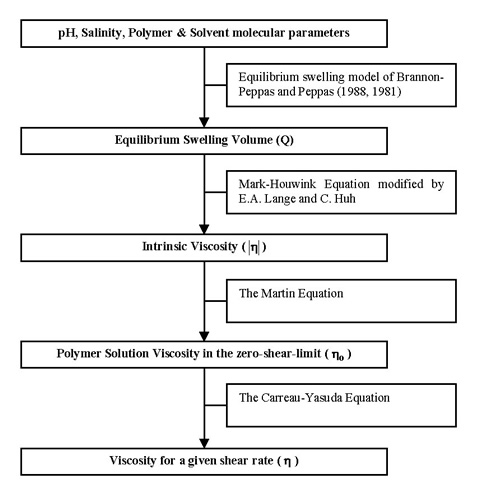The work will combine rheological measurements with laboratory-scale core-flow experiments and reservoir modeling. The laboratory experiments include characterization of the pH-sensitive anionic polymer, rheological studies, core, and long sand-pack tests to obtain the conditions and factors that impact the gelling characteristics of the polymer solution. The optimum operating parameters for different lithologies for water shut-off and mobility control will be obtained from these experiments and geochemical modeling. The simulation studies will use these parameters to obtain practical operating conditions for the application of the pH-sensitive gel.
Results
The overall objective of the proposed research is to develop a low-cost, pH-triggered polymer for use in polymer flooding to improve reservoir sweep efficiency and reservoir conformance in chemical flooding. The project’s main accomplishments over the first 9 months include rheological characterization of the polymers, proving the concept in the laboratory, and modeling the process geochemically.
Benefits
Polymer injectivity is of great concern in polymer flooding and profile control, since large injection pressures are needed to inject viscous fluids. The use of pH sensitive polymers provides a way of reducing the injection pressures needed to inject the polymer solution. By injecting a pH buffered polymer solution at low pH, we can achieve significantly lower injection pressures since the polymer viscosity is low. As the pH of the solution increases, due to reaction with the rock, the polymer viscosity increases by at least an order of magnitude. This allows lower injection pressures in polymer injection wells.
Summary
Rheological characterization was completed for several types of polyacrylic acid polymers with different crosslink density and molecular weight, in order to select the optimum polymer. Eight polymers were evaluated, and the results tabulated. All polymer solutions have the same tendency for viscosity change as a function of pH. The cross-linked polymers are tightly coiled in a low-pH environment and begin uncoiling (swelling) at a high pH to increase the viscosity. As expected, a lower concentration of polymer in solution lowers the viscosity value over all ranges. The project’s main accomplishments include:
- Rheological characterization of polymers. The rheological properties of polyacrylic acid polymer solutions were measured as a function of pH, salt concentration, polymer concentration, and temperature. The molecular weight and the cross-linking density of the eight polymers tested were varied. All the polymers tested showed a sharp increase in viscosity of the polymer at a pH of 3.5–4, indicating that pH can be used to trigger gelation. A comprehensive rheological model for aqueous polyacrylic acid solutions was developed to provide the polymer apparent viscosity as a function of pH, salinity, and shear rate—the polymer and solvent (brine) parameters. The model development is based on the observation that the thickening of the polymer solution comes from the swelling of cross-linked polymer microgels. The equilibrium-swelling model was correlated with intrinsic viscosity data to arrive at the apparent viscosity.
- Laboratory proof of concept. To assess the effectiveness of the polymer solution as a mobility control agent for conformance control, several core-flow tests and long-sand-pack tests were conducted. A 3 wt % sodium chloride brine solution was first injected to measure the original permeability of the Berea core. A 0.1M hydrochloric acid (HCl) solution was injected as a typical preflush. The core-flow tests showed that an HCl preflush can act as an effective pretreatment before polymer injection into the rock. Complete blocking of the core permeability (up to a pressure gradient of 1,000 psi/ft) was observed when the core was shut in and the pH was raised, indicating pH triggered in-situ gelation of the polymer.
- Geochemical modeling of the process. A very general geochemical model was used to model the changes in pH of the brine as the brine, HCl preflush, and the polymer are injected into the rock. The geochemical model results were calibrated with experimental core flow data (pH and elemental analysis data). Reasonable agreement with the core flow data indicated that the geochemistry was being adequately modeled. Such models will allow researchers to design and size preflushes and polymer slugs in field applications based on the mineralogy of the rock.




